Review – Is Halo Infinite worth playing now?
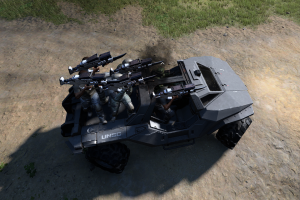
It’s fair to say 343 Industries probably haven’t enjoyed the success they expected when they took repsonsibility for the Xbox’s flagship franchise. Since taking the reigns from Bungie after the seminal Halo Reach, 343’s efforts have resulted in mixed results at best. Often impressing initially, 343’s Halo installments suffer from lacking the depth and polish of Bungie’s games, resulting in frustrated players abandoning them and going back to the classics via the Master Chief Collection.
With Halo Infinite, 343 promised to buck the trend and deliver a Halo experience that could endure past the initial hype, and provide Halo fans with a game they could play for years.
So did they deliver? Is Halo Infinite worth playing now?
Good
Graphical perfect blend: With Infinite, 343 have finally found an aesthetic that does the series justice. After deviating from the grittyness of Bungie’s installments and turning the Master Chief and other spartains into a clean cut, overly-shiny band of Power Rangers, Infinite tones the down the gloss and brings back the rugged looks of yore. There’s still a sleek look to some of the Forerunner artifacts on the planet, which works, as it provides nice juxtaposition with the rough-and-ready design of the human-made stuff. Infinite isn’t a huge leap in terms of technical achievement, but Halo has never been about delivering that. Rather, the aesthetic is more important, and 343 have finally found their feet in this regard.
Sandbox: Halo has always felt like a bit of a sandbox when it comes to the combat, and Infinite develops this concept quite well. As you explore the overworld, you unclock bases which allow you to restock on guns and ammo, order NPC soldiers around, and spawn vehicles. This is the best feature of the single player campaign – loading up a Warthog with 4 Spiker-wielding sidekicks and charging into a nearby enemy base is exhilarating chaos. Likewise, the ‘loop’ of the gunfights that has always been a cornerstone of Halo is still here and still works well, and the inclusion of the grappling hook adds another fun dimension to this flow, and is surely a feature that will remain in future games in the series.
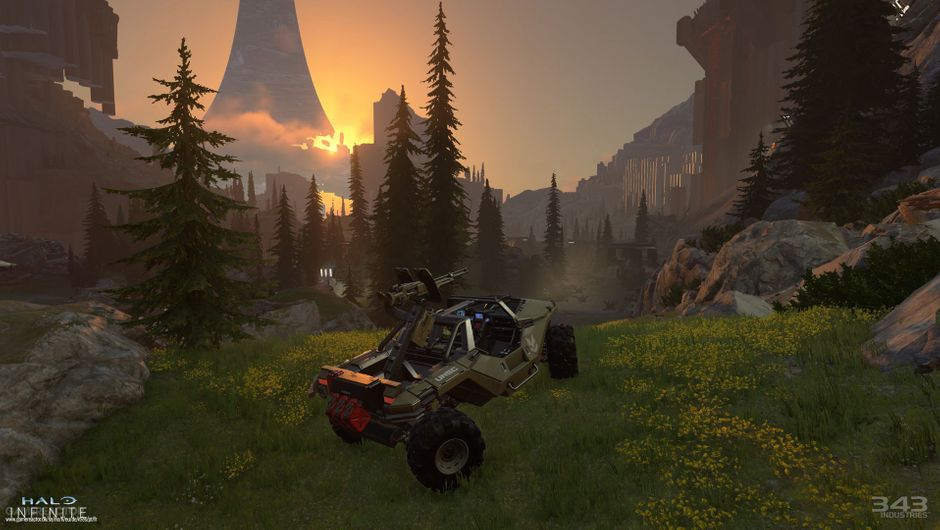
Bounty Hunting: Scattered throughout the campaign map are unique enemies that require you to hunt them down for bounties. Each of them have their own personality and unique traits, and come surrounded by a posse of henchmen. They’re really good fun to track down and take out, as there’s a Shadow of Mordor Nemesis-system-esque vibe to the hunts – and they represent the most challenging parts of the game. It’s just a shame the game doesn’t make more of these, as I think the whole game could’ve been more structured around this sort of concept.
Exploration: The big selling point of Inifnite: it’s the Halo we know and love, but open world. I’m generally a fan of the freedom open world frameworks provide, I take inherent joy in being able to explore anywhere and carve my own path. The key though is having an interesting world to explore, not only with enough ‘things’ to do, but also one that is aesthetically interesting; is structured in a way that feels like a living, brething space; and is fun to traverse. Infinite largely succeeds in most of these, with traversal being very well done with the grappling hook and vehicle combination, and the world itself having a nice mix of interiors, exteriors and verticality to it. The Halo formula does work in this system too, with clusters of enemies scattered throughout the map providing that classic Halo combat loop, knitting well into the large open landscape.
Vehicles: After just feeling a bit ‘off’ in Halo 4 and 5, I’m pleased to say 343 seem to have made a real effort in making the vehicles of Infinite feel weighty and ‘real’ again. The Scorpion now feels like the giant slow unstoppable death machine that it should be, and the variations on the Warthog are all good fun. Commandeering Ghosts and Banshees remains satifying during combat, and the newer vehicles all feel enjoyable to navitage with.
Grappling: The biggest change to the Chief’s own manouverability is the inclusion of the grappling hook. Initally it itseems like a simplistic inclusion, and it’s something other games have done, but unlike when 343 added the sprint button in, it doesn’t feel like it goes against what makes Master Chief the Chief. Far from becoming a nimble Spider-man, the hook is limited enough to give you another dimension to traversal (and a much needed vertical option with the game’s terrain), but also retain the Chief’s sense of weightiness that makes him so unique to control. The extra things you can do with the grapple are great fun too – stealing an enemy weapon or pulling them in to beat them down never gets old. It’s the best new addition to the series that Infinite brings to the table.
Heroic: As with most of the Halo games, I find the Heroic difficulty to be the real sweet spot in terms of challenge. Each encounter feels tough but not to the point of unfairness, and makes progressing through the game feel rewarding but not frustrating. Legendary difficulty is just masochistic, and Normal or Easy just feel too much like a cakewalk. Heroic all the way.
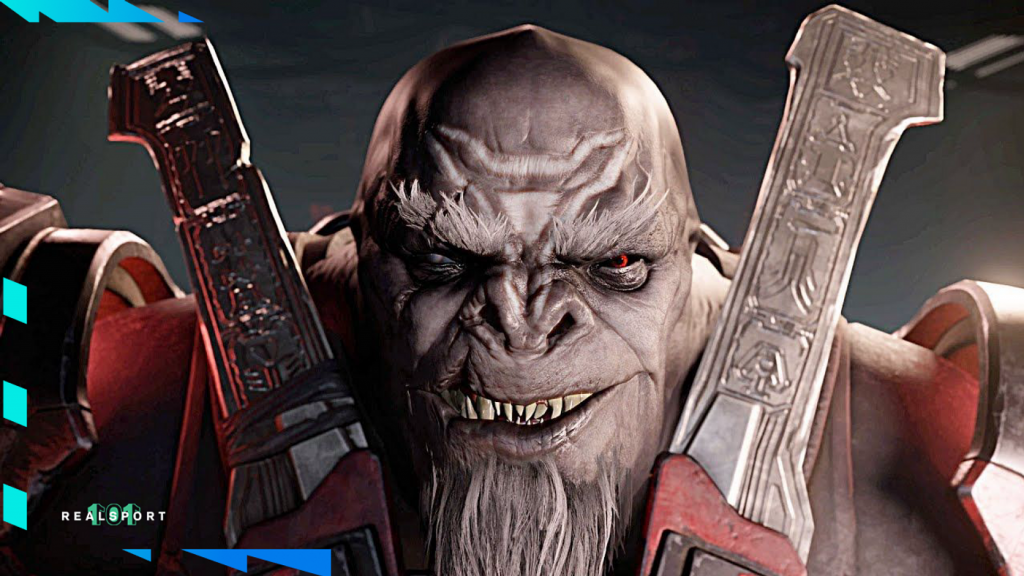
Training bit: Before you jump into the multiplayer, there’s a really nice little training section that somehow avoids the drudgery of most equivalent segments in other games. Maybe it’s the joy of being in this freshly built Master Chief’s shoes for the first time, with the excitement and possibility of what’s to come, but something about it was really done right.
Gunplay: The moment-to-moment gunplay in Infinite is good. It’s fun and frantic. The guns feel like they pack a punch, and they’ve really improved the Forerunner arsenal from the previous games. Going head-to-head against a foe in multiplayer feels exhilarating and a real battle of skill, with Spartans moving at a good speed and having a good feeling of weight behind them. Does it feel as good as Halo 2 or 3? Not quite, but it’s the closest the series has come since.
Skulls hidden: The skulls are of course back, and of course they’re hidden in hard-to-find places. What I really like about them in Inifinite, though, is that they serve as a reward for exploraiton on the game’s open world. Climbing a random maountain in an open world game should reward you with something tangible, and whilst there aren’t quite enough of these mini-rewards in Inifinte, the skulls serve as a good one.
Music: I found the music to be good in Halo Infinite. It was fittingly grandiose in places, and subdued in others. It’s not quite up to Halo 2 standards, but then, what is?
Mixed
Enemies: All the favourites are back in action – Brutes, Elites, Grunts, Jackals – and they’re all as serviceable as they have been before. The AI is good, with enemies ducking for cover, flanking, calling for backup or fleeing accordingly. But the array of enemies on offer really feels like it needs freshening up in the series as a whole. Yes, it’s fun taking on a couple of Elites and five Grunts. But how many times have we done it by now? If i were designing a new Halo, I’d completely start from scratch with the enemy types.
Ubisoft mappy: As good as some elements of the overworld is, like so many others Infinite commits the cardinal sin of being Ubisoft-y. What do I mean by this? Well, when you open up your map, you’ll get a sea of Icons, indicating point sof interest and little secrets. On the face of it, this is useful. But in reality, it completely defeats the purpose of any player-guided exploration, and negates the whole point of the open world. If I spot a cavern, and there’s an icon for a weapon stash or an audiolog, then fine – I ‘ll go to it. But where’s the sense of discovery? Converseley, if there is no icon, then I know there’s absolutely no point in checking out the cavern. The iconography is killing the experience two-fold. Just give us icon-less maps an we’ll all have a better time. See Breath of the Wild for how it should be done.
Multiplayer maps: On launch, the map selection in Infinite was frankly a disgrace. Why on earth these games can’t instantly ship with the classics form older games, just to give us some variety, I don’t know. How is it looking now? Well, it’s better, but still not great. Some of the new maps are good fun, but other’s are just either pale imitations of classic maps, or simply bad.
Bad
Where’s Slayer? OK, it’s in the game now, but Infinite initially shipped without a Slayer multiplayer gametype. Easily the most popular. And this inexplicable decision is indicative of the ineptitude that surrounded this game’s launch, and, sadly, still eminates from it like a bad smell. The disconnect between what 343 deliver and what the Halo fans actually want beggars belief at times, and nowhere more so than…
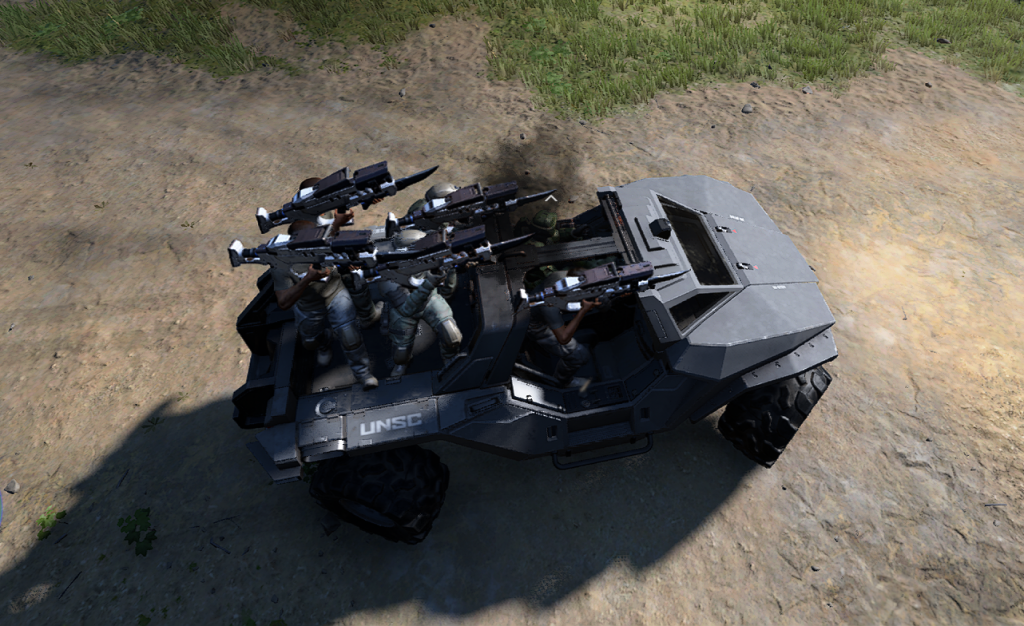
No co-op: Infite shipped without any co-op whatsoever. After a year, they finally shipped online co-op. But there’s still no local co-op. For me, some of my best Halo-related memories were playing through campaings locally with my friends in split-screen. To not ship this supposed ‘ultimate’ Halo experience with this option is just unacceptable.
Map diversity: There are some good things about the campaign map that I’ve discussed, but it does lack in many ways. Firstly, it just isn’t very large, with hard invisible wall borders and many convenient holes blasted through the floor, making for the terrain that’s actually traversible to feel somewhat minimal and narrow. There’s also a diversity problem – Halo games of yore have taken us on journeys across multiple planets and ecosystems, but this small slice of Zeta Halo (where we’re based in Ininifte) is really just trees, grass, rocks and metallic structures. It looks fine, but where’s the snow? Where’s the lava? Where’s the jungle? Nowhere. It all feels like this was a rushed downsizing, especially when you comapre it to the vistas of the game’s early trailers.
Cutscenes: There was something that felt rather ‘off’ about the cutscenes in the game that I couldn’t quite put my finger on, and then I realised – they’re all up close and personal. Chief takes up at least 75% of the screen on each scene. Whether this was a deliberate style choice, or again it was a way to cut corners so they didn’t have to render complex scenery, I dont know. But it culminates in a weird, uncomfortable feeling when wathcing them. Not good.
Intro too long: Whilst the training sequence for the multiplayer was good, the into to the campaign is a slog. It takes a good 45 minutes before you’re able to start exploring the surface of Zeta Halo, and most of it is just cutscene and a bizarre QTE sequence of you jumping from falling rubble. It’s not a good start.
Cheesy dialogue: Most of the cutscenes involve the Chief and the pilot Esparza chatting to each other about how doomed they are. The script is, frankly, cheesy and doesn’t possess any of the subtlety of Bungie’s efforts. Older Halo games benefitted from a less-is-more, understated approach to dialogue, but in Ininite we get reams and reams of corny tropes, and worst of all – Chief himself isn’t immune to this. The mostly-silent, stoic protagonist of old has been morphed into a quippy Marvel character. A real disappointment.
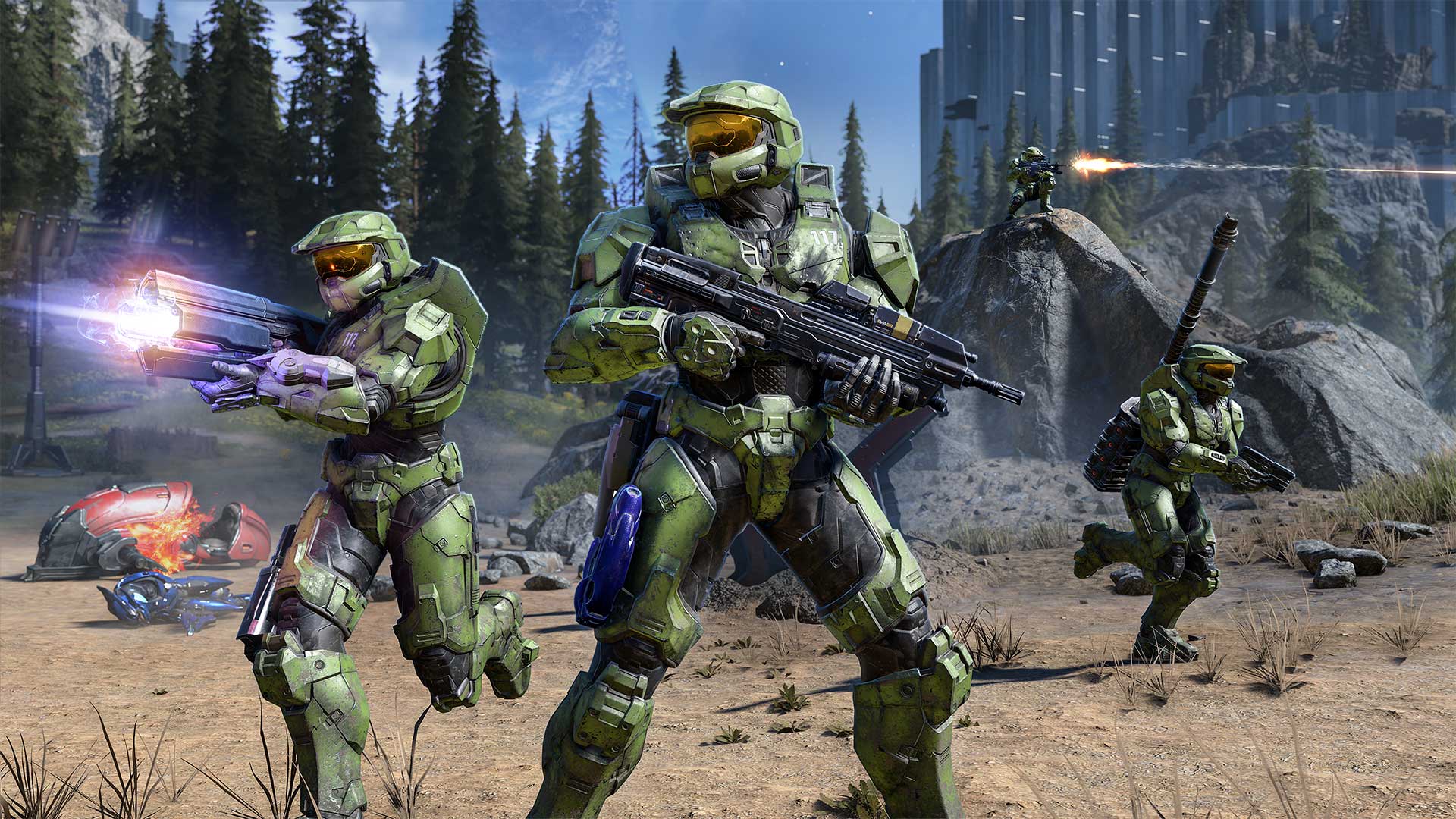
It’s no MCC: After a few hours with the game, I’m sad to say I found myself longing for the older games in the Master Chief Collection – from both a multiplayer and singlepplayer perspective. It’s just simply not as well-made, polished, deep, or as fun as what came before it, making it feel somewhat redundant as a package.
Who are these people? For all the good points about the campaign, the experience really tails off after the first few hours, particularly with the narrative. There are several antagonists in the game, but ant no point do we really get a feel for who they are, what their motives are, or what they’re doing on Zeta Halo. It all feels very ill-conceived and half-baked. A good example is with the introduction at the start of the game to a Super-Elite dubbed the Spartan Killer, who gets ordered at the start of the game by the Big Baddie to hunt the Chief down. I thought that this might mean that he’d appear at random points during the playthrough on the map, to be fended off at unexpected, inconvenient times. But nope – we don’t see him at all until the end of the story, where we fight him as a miniboss before the main boss. Great? It all feels just very shoddy.
Microtransactions: No one likes in-game stores or microstransactions, but in Ininifte they really are a bit of a joke. Many things that came as standard in former entries are now locked behind payable micro transactions, with even armour colours requiring money to unlock. It just represents everything wrong with modern gaming, and has rightly inspired vitriol from the Halo fanbase.
It’s not Infinite: Halo Infinite is a small, half-baked game with some good ideas. With Infinite, 343 promised us a Halo that we’d be playing for years, but the word ‘infinite’ couldn’t be less apt for what they’ve served up here.
Overall
Halo Infinite is a disappointing experience, and sadly what we’ve come to expect from 343 Industries. Some initial promise and good ideas are completely overshadowed by bizarre decisions, poor design and completely barebones features. It all comes together to give somhting that left me feeling hollow, and does not live long in the memory. A big missed opportunity, and absolutely not worth playing now. 3/10.
For a Halo experience much more worth your time, check out our MCC review here.